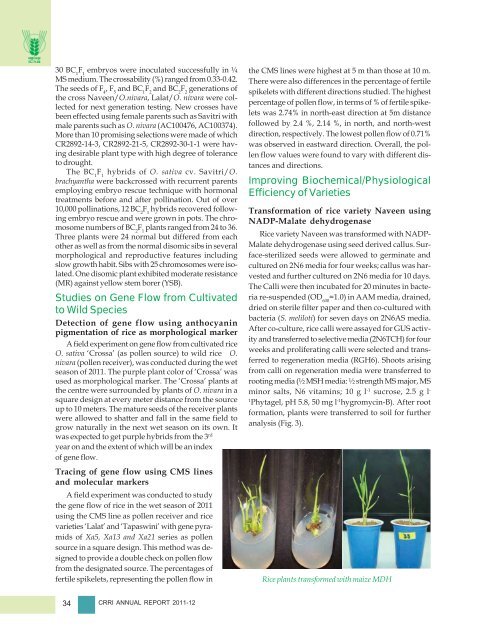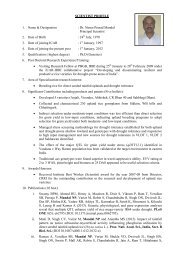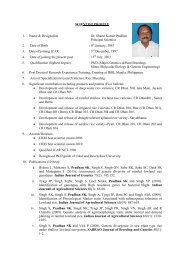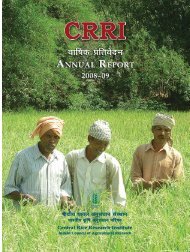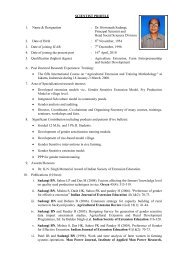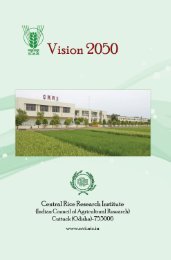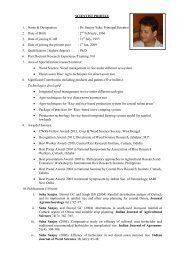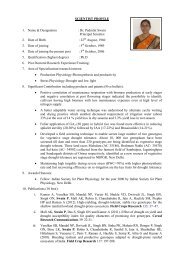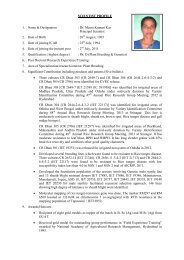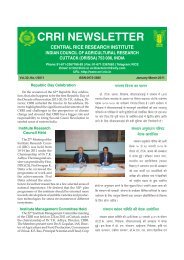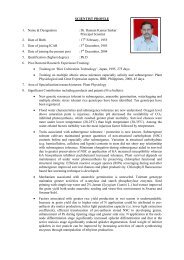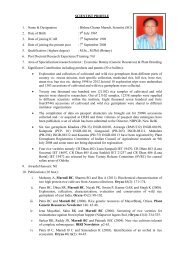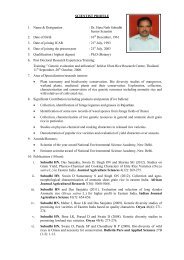Central Rice Research Institute Annual report...2011-12
Central Rice Research Institute Annual report...2011-12
Central Rice Research Institute Annual report...2011-12
Create successful ePaper yourself
Turn your PDF publications into a flip-book with our unique Google optimized e-Paper software.
30 BC 1<br />
F 1<br />
embryos were inoculated successfully in ¼<br />
MS medium. The crossability (%) ranged from 0.33-0.42.<br />
The seeds of F 4<br />
, F 5<br />
and BC 1<br />
F 2<br />
and BC 2<br />
F 2<br />
generations of<br />
the cross Naveen/O.nivara, Lalat/O. nivara were collected<br />
for next generation testing. New crosses have<br />
been effected using female parents such as Savitri with<br />
male parents such as O. nivara (AC100476, AC100374).<br />
More than 10 promising selections were made of which<br />
CR2892-14-3, CR2892-21-5, CR2892-30-1-1 were having<br />
desirable plant type with high degree of tolerance<br />
to drought.<br />
The BC 1<br />
F 1<br />
hybrids of O. sativa cv. Savitri/O.<br />
brachyantha were backcrossed with recurrent parents<br />
employing embryo rescue technique with hormonal<br />
treatments before and after pollination. Out of over<br />
10,000 pollinations, <strong>12</strong> BC 2<br />
F 1<br />
hybrids recovered following<br />
embryo rescue and were grown in pots. The chromosome<br />
numbers of BC 2<br />
F 1<br />
plants ranged from 24 to 36.<br />
Three plants were 24 normal but differed from each<br />
other as well as from the normal disomic sibs in several<br />
morphological and reproductive features including<br />
slow growth habit. Sibs with 25 chromosomes were isolated.<br />
One disomic plant exhibited moderate resistance<br />
(MR) against yellow stem borer (YSB).<br />
Studies on Gene Flow from Cultivated<br />
to Wild Species<br />
Detection of gene flow using anthocyanin<br />
pigmentation of rice as morphological marker<br />
A field experiment on gene flow from cultivated rice<br />
O. sativa ‘Crossa’ (as pollen source) to wild rice O.<br />
nivara (pollen receiver), was conducted during the wet<br />
season of 2011. The purple plant color of ‘Crossa’ was<br />
used as morphological marker. The ‘Crossa’ plants at<br />
the centre were surrounded by plants of O. nivara in a<br />
square design at every meter distance from the source<br />
up to 10 meters. The mature seeds of the receiver plants<br />
were allowed to shatter and fall in the same field to<br />
grow naturally in the next wet season on its own. It<br />
was expected to get purple hybrids from the 3 rd<br />
year on and the extent of which will be an index<br />
of gene flow.<br />
Tracing of gene flow using CMS lines<br />
and molecular markers<br />
A field experiment was conducted to study<br />
the gene flow of rice in the wet season of 2011<br />
using the CMS line as pollen receiver and rice<br />
varieties ‘Lalat’ and ‘Tapaswini’ with gene pyramids<br />
of Xa5, Xa13 and Xa21 series as pollen<br />
source in a square design. This method was designed<br />
to provide a double check on pollen flow<br />
from the designated source. The percentages of<br />
fertile spikelets, representing the pollen flow in<br />
the CMS lines were highest at 5 m than those at 10 m.<br />
There were also differences in the percentage of fertile<br />
spikelets with different directions studied. The highest<br />
percentage of pollen flow, in terms of % of fertile spikelets<br />
was 2.74% in north-east direction at 5m distance<br />
followed by 2.4 %, 2.14 %, in north, and north-west<br />
direction, respectively. The lowest pollen flow of 0.71%<br />
was observed in eastward direction. Overall, the pollen<br />
flow values were found to vary with different distances<br />
and directions.<br />
Improving Biochemical/Physiological<br />
Efficiency of Varieties<br />
Transformation of rice variety Naveen using<br />
NADP-Malate dehydrogenase<br />
<strong>Rice</strong> variety Naveen was transformed with NADP-<br />
Malate dehydrogenase using seed derived callus. Surface-sterilized<br />
seeds were allowed to germinate and<br />
cultured on 2N6 media for four weeks; callus was harvested<br />
and further cultured on 2N6 media for 10 days.<br />
The Calli were then incubated for 20 minutes in bacteria<br />
re-suspended (OD 600<br />
=1.0) in AAM media, drained,<br />
dried on sterile filter paper and then co-cultured with<br />
bacteria (S. meliloti) for seven days on 2N6AS media.<br />
After co-culture, rice calli were assayed for GUS activity<br />
and transferred to selective media (2N6TCH) for four<br />
weeks and proliferating calli were selected and transferred<br />
to regeneration media (RGH6). Shoots arising<br />
from calli on regeneration media were transferred to<br />
rooting media (½ MSH media: ½ strength MS major, MS<br />
minor salts, N6 vitamins; 10 g l -1 sucrose, 2.5 g l -<br />
1<br />
Phytagel, pH 5.8, 50 mg l -1 hygromycin-B). After root<br />
formation, plants were transferred to soil for further<br />
analysis (Fig. 3).<br />
<strong>Rice</strong> plants transformed with maize MDH<br />
34 CRRI ANNUAL REPORT 2011-<strong>12</strong>


